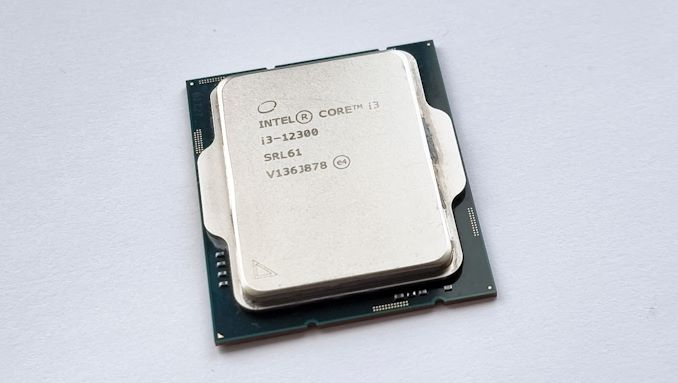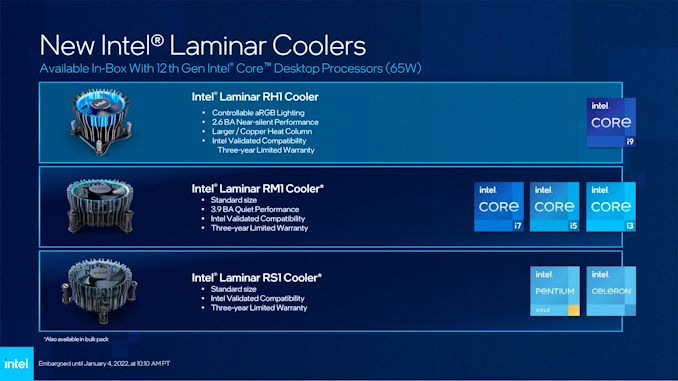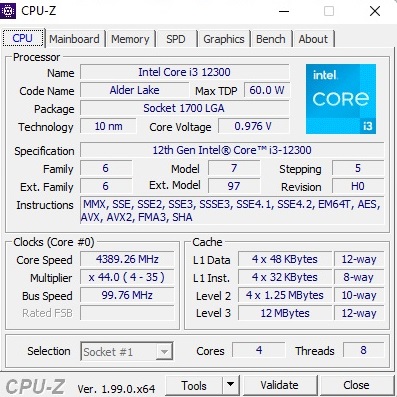The Intel Core i3-12300 Review: Quad-Core Alder Lake Shines
by Gavin Bonshor on March 3, 2022 8:30 AM EST
Just over a month ago Intel pulled the trigger on the rest of its 12th generation "Alder Lake" Core desktop processors, adding no fewer than 22 new chips. This significantly fleshed out the Alder Lake family, adding in the mid-range and low-end chips that weren't part of Intel's original, high-end focused launch. Combined with the launch of the rest of the 600 series chipsets, this finally opened the door to building cheaper and lower-powered Alder Lake systems.
Diving right in, today we're taking a look at Intel's Core i3-12300 processor, the most powerful of the new I3s. Like the entire Alder Lake i3 series, the i3-12300 features four P-cores, and is aimed to compete in the entry-level and budget desktop market. With prices being driven higher on many components and AMD's high-value offerings dominating the lower end of the market, it's time to see if Intel can compete in the budget desktop market and offer value in a segment that currently needs it.
Below is a list of our detailed Intel Alder Lake and Z690 coverage:
- The Intel 12th Gen Core i9-12900K Review: Hybrid Performance Brings Hybrid Complexity
- Intel Architecture Day 2021: Alder Lake, Golden Cove, and Gracemont Detailed
- Intel Announces 12th Gen Core Alder Lake: 22 New Desktop-S CPUs, 8 New Laptop-H CPUs
- The Intel Z690 Motherboard Overview (DDR5): Over 50+ New Models
- The Intel Z690 Motherboard Overview (DDR4): Over 30+ New Models
As a quick recap, we've covered Alder Lake's dual architectural hybrid design in our Core i9-12900K review, including the differences between the P (performance) and E (efficiency cores). The P-cores are based on Intel's high-performance Golden Cove architecture, providing traditional high single-threaded performance. Meanwhile the Gracemont-based E-cores, though lower performing on their own, are significantly smaller and draw much less power, allowing Intel to pack them in to benefit multi-threaded workloads.
Intel Core i3-12300 Processor: Less is Moore
Aside from the two top Core i5 models (i5-12600K and i5-12600KF), all of chips below that level, including the Core i3, Pentium, and Celeron series, only feature Intel's Golden Cove P-cores. Intel's 12th generation Core i3 processors feature four such P-cores, with 12 MB of L3 cache, and all but one (i3-12100F) uses Intel's Xe-LP architecture-based UHD 730 integrated graphics.
Intel's 12th generation Alder Lake desktop processors have been split into the following naming schemes and Performance (P) core and Efficiency (E) core configurations:
- Core i9: 8 Performance Cores + 8 Efficiency Cores
- Core i7: 8 Performance Cores + 4 Efficiency Cores
- Core i5: 6 Performance Cores + 4 Efficiency Cores/6P Only
- Core i3: 4 Performance Cores Only
- Pentium: 2 Performance Cores Only
- Celeron: 2 Performance Cores Only
The Intel Core i3-12300 is the top i3 SKU in the lineup and has a base frequency of 3.5 GHz (60 W), with a turbo frequency of 4.4 GHz (89 W). Other variants vary in core frequency, with different models focusing on lower-powered systems, including the Core i3-12300T, which has a base TDP of 35 W at 2.3 GHz, with turbo clock speeds reaching 4.2 GHz with a 69 W TDP.
| Intel Core i3 Series (12th Gen Alder Lake) | ||||||||
| Processor | Cores P+E |
P-Core Base (MHz) |
P-Core Turbo (MHz) |
L3 (MB) |
IGP | Base (W) |
Turbo (W) |
Price ($1ku) |
| i3-12300 | 4+0 | 3500 | 4400 | 12 | 730 | 60 | 89 | $143 |
| i3-12300T | 4+0 | 2300 | 4200 | 12 | 730 | 35 | 69 | $143 |
| i3-12100 | 4+0 | 3300 | 4300 | 12 | 730 | 60 | 89 | $122 |
| i3-12100F | 4+0 | 3300 | 4300 | 12 | - | 58 | 89 | $97 |
| i3-12100T | 4+0 | 2200 | 4100 | 12 | 730 | 35 | 89 | $122 |
At the time of writing, there are five Core i3 processors announced so far. While the interpretation of TDP can be taken in different ways depending on the company and how it is measured, Intel has gone one step further by offering both TDP at the base frequency and turbo frequencies. Three of these are standard non-K SKUs, while two of these feature the T naming moniker, which signifies that they have a base TDP of just 35W, perfect for lower-powered systems.
Interestingly, only one of the Core i3 processors, the i3-12300T has a turbo TDP of 69 W, while the rest have a rating of 89 W with turbo enabled, including the i3-12100T. The odd one out is the Core i3-12100F, which has a slightly lower base TDP of 58 W, likely as this is the only Core i3 not to include Intel's UHD 730 integrated graphics. It is also the cheapest, with a per 1k unit price of $97.

For this generation Intel has also refreshed its stock CPU coolers, which is the first time it has done this in quite a long time. Although none of the K-series processors include one, aftermarket cooling is necessary to utilize its Thermal Velocity Boost (TVB) and Intel's new 'infinite turbo.' This means that the processor under heavier workloads will try and use turbo as much as possible, which can mean better cooling is needed on the parts with higher P and E-core counts. In the case of the Core i3 series, the maximum TDP figure Intel provides is 89 W, so any conventional CPU cooler should be able to sustain turbo clock speeds for a more extended period of time.
The Core i3 series is shipped and bundled with Intel's new Laminar RM1 CPU cooler, which is similar in size to previous iterations of its stock cooler. Unlike the RH1, the RM1 doesn't feature RGB LED lighting and uses a traditional push-pin arrangement to mount into the socket. Intel hasn't stated which material it uses, e.g., copper or aluminum, or a combination of the two, but regardless of the materials used, for sub 100 W workloads these coolers should be more than ample for the Core i3 series.
The Budget CPU Market: Core i3-12300 versus AMD
Users have lots of choices available in terms of LGA1700 motherboards, including Z690, B660, H670, and H610, as well as support for either DDR5 and DDR4 memory. Users can pair up the Core i3-12300 with the more expensive DDR5 and Z690 for the absolute greatest performance, but the target audience for the Core i3 is users on a budget. This means that users are more likely from a cost perspective to build a system with one of the more affordable B660, H670, and H610 chipsets and pair that with DDR4 memory.
In terms of the competition from AMD, the green team is effectively absent from the sub-$200 quad core market for the moment. AMD does have a more-or-less direct competitor to the Alder Lake i3s in the Ryzen 3 5300G. However, as that chip is OEM-only (and terribly expensive on the gray market), as far as the retail market and individual system builders are concerned, it's all but unavailable. Which means that, at least amidst the ongoing chip crunch, Intel has the run of the market below $200. That said, we are including it in our graphs for completion's sake, and to outline where AMD would be if they could provide their quad core chips in greater volumes.
The next best competitor for the i3-12300 then is arguably the Ryzen 5 5600X, which is an ambitious task and admittedly somewhat lopsided task. The AMD Ryzen 5 5600X is based on its Zen 3 architecture and has six cores versus the four of the i3-12300, while the 5600X also benefits from four more threads (12). Intel's Alder Lake architecture also benefits from PCIe 5.0, but right now there aren't any (consumer) devices that can utilize the extra bandwidth available. The AMD Ryzen 5000 series uses PCIe 4.0 on X570, with PCIe 4.0/3.0 on B550 and below.

Intel Core i3-12300 CPU-Z screenshot, 4C/8T
Aside from architectural, core count, and thread count differences between the Intel Core i3-12300 and the AMD Ryzen 5 5600X, the next biggest difference is the price. The Ryzen 7 5600X has an MSRP of $299, although it can be found at Amazon at the time of writing for a recently trimmed price of $229. The Intel Core i3-12300 is much cheaper in contrast, with a per 1k unit pricing of $143. With the first shipments just now hitting the market, we expect the retail MSRP to be around the $160-170 mark.
Other processors from AMD that could be considered competitors are the 5000 series Cezanne APUs. This includes the Ryzen 5 5600G, which is currently $219 at Amazon. Despite being more focused on entry-level gaming with integrated Vega 7 graphics, it consists of six cores with a base frequency at 3.9 GHz and a turbo frequency of 4.4 GHz; the 5600G also benefits from twelve threads.
Finally, boxing things in from the other direction, Intel also has the Core i5-12600K processor with six P-cores and four E-cores, with a price tag of $280 at Newegg. We will be reviewing the Core i5 a bit later this month, and it is currently on our testbed undergoing our CPU test suite at the time of writing.
Test Bed and Setup
Although there were some initial problems with the Intel Thread Director when using Windows 10 at the launch of Alder Lake, the P-core only Core i3 stack doesn't need to worry about this. For our testing, we are running the Core i3-12300 with DDR5 memory at JEDEC specifications for Alder Lake (DDR5-4800 CL40). We are also using Windows 11 from now on for our CPU reviews.
For our test bed, we are using the following:
| Alder Lake Test System (DDR5) | |
| CPU | Core i3-12300 ($143) 4+0 Cores, 8 Threads 60W Base, 89W Turbo |
| Motherboard | MSI Z690 Carbon WI-FI |
| Memory | SK Hynix 2x32 GB DDR5-4800 CL40 |
| Cooling | MSI Coreliquid 360mm AIO |
| Storage | Crucial MX300 1TB |
| Power Supply | Corsair HX850 |
| GPUs | NVIDIA RTX 2080 Ti, Driver 496.49 |
| Operating Systems | Windows 11 Up to Date |
All other chips for comparison were run as tests listed in our benchmark database, Bench, on Windows 10.










140 Comments
View All Comments
mode_13h - Friday, March 11, 2022 - link
Always glad to share!I know about laziness. I probably should be working on programming puzzles, since I hear job interviews tend to be big on those. The last time I did anything like that was Google's "foobar", which was pretty fun. I did well enough to get an interview, but I didn't pursue it.
GeoffreyA - Monday, March 14, 2022 - link
I really wish I had known about these things, or that they had existed, 10-15 years ago. I had a thirst for programming back then and, if I may say so, would've done well. I've let go of thinking of myself as a programmer any more, but still hope to keep up an acquaintance with code.mode_13h - Monday, March 14, 2022 - link
Anything to keep your mind active is good!Especially learning *new* things. The first time I tried to learn another spoken language, as an adult, I could feel the blood rushing to my brain as I struggled to remember and pronounce new words and phrases.
GeoffreyA - Monday, March 14, 2022 - link
Absolutely!I am learning francaise, the beautiful language itself these days (and incidentally, it makes me so disappointed in English as always). There was a great article on Quanta last week that really got my brain working too.
https://www.quantamagazine.org/crisis-in-particle-...
mode_13h - Tuesday, March 15, 2022 - link
OMG, I stay away from any cutting-edge theoretical physics. I'm not investing that much effort into trying to understand something that will likely turn out to be wrong. It'd be different if I had a stake in the matter, but there's more than enough more practical stuff I should be learning.But, if you enjoy it, and trying to wrap your head around it, then it's far from the worst way you could spend your time!
GeoffreyA - Friday, March 18, 2022 - link
I enjoy it, and wish I was a physicist, but it does drain out the mind considerably, and afterwards one feels it's all rather meaningless, and it's the practical business of life that really counts: love, family, work, etc.mode_13h - Friday, March 18, 2022 - link
A lot of physicists don't have a career doing physics!It's not a bad field of study, but it doesn't pay the bills for many.
That said, I'm sure all the big quantum computing projects are staffed by some of the best physicists.
GeoffreyA - Saturday, March 19, 2022 - link
Yep, there's big money to be made in this field right now. Intel should jump on the quantum bandwagon any day now, if they haven't already done so.Silver5urfer - Thursday, March 3, 2022 - link
High respect to AT team, for mentioning the fundamental design flaw of this 12th generation. Intel really screwed up hard. Nobody cares, esp those Youtubers.They messed up the ILM hard. And the AVX512 fuse off is another gigantic kick in the face, latest update they are saying Intel will fuse them off from factory. If we see the silicon area on the ADL processors for P cores it occupies a good chunk of space plus it allows the P core to fully unleash it's performance (no more E-Cores hampering the Uncore and Powerplane and overall CPU performance)
Prime reason to skip this entire 12th gen, esp with the new rumors saying RPL LGA1700 Z700 chipset might be DDR5 only, so you get this haphazardly designed ILM which requires end user to perform a Socket mod (I would not do it despite love tinkering because the torque and all the fitting is not public, Igor clearly mentioned this) for DDR4 or buy the uber expensive DDR5 kits which have 2 flaws on their own - Price to performance, Dual Rank kits mandatory for ADL IMC to maximize the quad channel speed and performance, a.k.a needing APEX or Unify X or Tachyon all top end boards HWBot grade.
Intel really messed this, a solid CPU Arch but from an enthusiast point of view who wants to use a PC for decades going forth. AMD also, AM4 has it's own share of issues - AGESA1.2.0.5 is busted, they still did not fix the IOD USB issues through firmware, it has been plaguing the platform. And now no more X3D CPUs refresh which would have perfectly fixed all the firmware problems and IOD and DRAM plus the WHEA. Sad, still Ryzen is best if you do not want to OC or tweak just enable PBO2 and that's it. Let it do it's job, and do not touch DRAM past 3600MHz. For Intel LGA1200 10th gen is best for SMT performance and all workloads for those who want PCIe4.0 (still not a big deal because not much use) a 11900K is fine but the absolute worst class of binning, poor IMC is a strict no no. The biggest loss going with LGA1200 Z590 is DMI speed is very low. But since majority will not saturate the NVMe on a constant load it is okay, a shame if 10900K had DMI of 11th gen it would have been solid since both X570 and Z590 are practically same in PCH link lanes, only on the CPU side Ryzen has extra USB but with the crapping out it doesn't make sense, at-least to me.
AM5 needs maturity as well, first customers will always end up being guinea pigs. Still I would like to see how AMD plays their game, and I'm looking forward since it won't have BS E-Core crap. Full fast fat cores.
Makaveli - Thursday, March 3, 2022 - link
No USB issues here on AGESA 1.2.0.3 Patch C or WHEA.